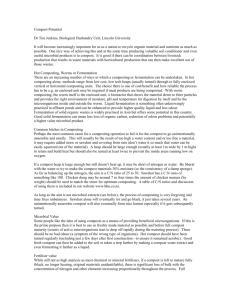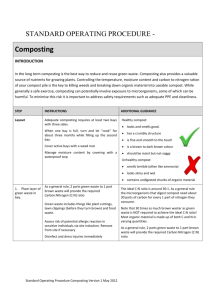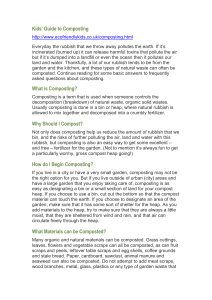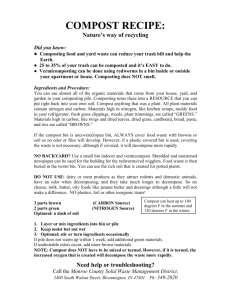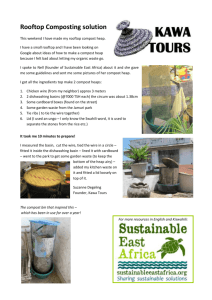Composting
advertisement
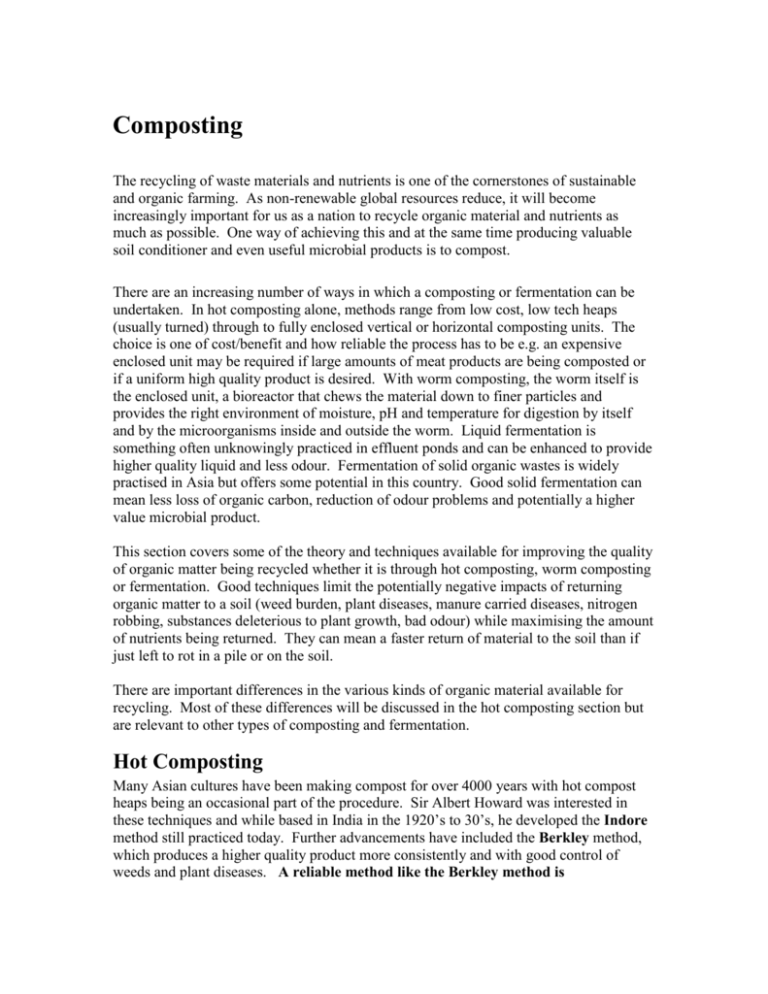
Composting The recycling of waste materials and nutrients is one of the cornerstones of sustainable and organic farming. As non-renewable global resources reduce, it will become increasingly important for us as a nation to recycle organic material and nutrients as much as possible. One way of achieving this and at the same time producing valuable soil conditioner and even useful microbial products is to compost. There are an increasing number of ways in which a composting or fermentation can be undertaken. In hot composting alone, methods range from low cost, low tech heaps (usually turned) through to fully enclosed vertical or horizontal composting units. The choice is one of cost/benefit and how reliable the process has to be e.g. an expensive enclosed unit may be required if large amounts of meat products are being composted or if a uniform high quality product is desired. With worm composting, the worm itself is the enclosed unit, a bioreactor that chews the material down to finer particles and provides the right environment of moisture, pH and temperature for digestion by itself and by the microorganisms inside and outside the worm. Liquid fermentation is something often unknowingly practiced in effluent ponds and can be enhanced to provide higher quality liquid and less odour. Fermentation of solid organic wastes is widely practised in Asia but offers some potential in this country. Good solid fermentation can mean less loss of organic carbon, reduction of odour problems and potentially a higher value microbial product. This section covers some of the theory and techniques available for improving the quality of organic matter being recycled whether it is through hot composting, worm composting or fermentation. Good techniques limit the potentially negative impacts of returning organic matter to a soil (weed burden, plant diseases, manure carried diseases, nitrogen robbing, substances deleterious to plant growth, bad odour) while maximising the amount of nutrients being returned. They can mean a faster return of material to the soil than if just left to rot in a pile or on the soil. There are important differences in the various kinds of organic material available for recycling. Most of these differences will be discussed in the hot composting section but are relevant to other types of composting and fermentation. Hot Composting Many Asian cultures have been making compost for over 4000 years with hot compost heaps being an occasional part of the procedure. Sir Albert Howard was interested in these techniques and while based in India in the 1920’s to 30’s, he developed the Indore method still practiced today. Further advancements have included the Berkley method, which produces a higher quality product more consistently and with good control of weeds and plant diseases. A reliable method like the Berkley method is recommended where practical and is likely to also be required by certification if non(organic) certified material is being composted. The Indore method involves building a heap to the height of 1.5 metres with a base of 2m by 2m tapering up to about 1.2m by 1.2m – made up of layers. The first layer is brush or similar to improve drainage. Then there are alternate layers of low nitrogen and high nitrogen material and the heap is often then covered in 5cm of compacted soil to reduce fly issues and contain odours and loss of nitrogen. If left unturned the heap would usually be ready after one year. Otherwise turning after 8-10 days then after a month would give useable compost after a total of 2-3 months. Anaerobic conditions are common in the Indore method (especially without turning) meaning potential smell issues (if the soil casing is missed out). The heap can be made over time (many home garden composts are in that way similar to the Indore method) but this is not ideal and will usually mean a lack of temperature build up and therefore a slower process with lack of weed and disease control. The strict Berkley method still involves layers of low nitrogen and high nitrogen material. This is often the easiest way to construct a large scale heap anyway but as long as the heap doesn’t become too compacted, mixed materials are okay. A heap should be at least one cubic metre, usually no taller than 1.5m (if there is risk of compacted soggy areas in the middle to bottom of the heap by around 1-2m wide and as long as required. The important difference from the Indore method is that the heap is turned regularly, preferably after 3-4 days and then every 2-3 days until the end of the fortnight. It may then be ready for use (in some cases it could be “matured” for longer if not sufficiently decomposed. Attention should be paid to either reducing leaching or capturing leachate. Reduced leaching can be achieved by covering the heap and/or by having a solid non-leaching base. The base can be designed to allow capture of leachate which can then be diluted and used as a resource in itself (biofertiliser). Windrow Compost Heaps Windrow composting is large scale hot composting generally done with machinery and can produce compost in sufficient quantities for small to medium size farms. The Berkley method can be appropriate here but the labour content can make this impractical on a large scale. Once sufficient materials have been collected, layers are alternated as per the Indore or Berkley methods. Height should be restricted to 1.5 metres (possibly to 2 m with some material) to avoid compaction problems. The heap is turned after 4 – 7 days and then again a fortnight later or turned more frequently according to the Berkley method if this is practical. 3-stage bin composting This is possibly the most popular method of hot compost production in New Zealand at a back yard level. As with the windrow method, this is a batch process with material being accumulated prior to ‘putting down’ the compost. Once a suitable quantity of material has been accumulated the 1st bin is filled with alternating layers of nitrogen rich and poor materials. The level of moisture in the heap/bin is also addressed. Once the bin is full there is a period of about 2 weeks where the heap heats up and begins to cool down. When the heap starts to cool it is ready to be turned in to the 2nd bin. Ensure thorough mixing while turning the heap. Try to ensure that all material that was on the outside of the heap is on the inside after this turning. After a further two weeks turn heap from bin 2 to bin 3 where final maturation takes place. This method, whilst the most convenient on a small scale, is not 100% effective for the killing of weed seeds. Generally the greater the frequency of turning (within reason) the greater the kill of weed seeds and pathogens. The microbiology of hot composts The entire composting process is mediated by microorganisms. We should not let go of this fact and this fact should be used to ensure that we make the heap suitable for them. Composting is forgiving but it is best not set and forget. Conditions for Compost Microorganisms Good moisture (consistency of a damp sponge) that is neither too wet (leading to smelly, slow, and poor quality anaerobic compost) nor too dry (very slow, water repelling, improperly decomposed compost) is important. It seems the usual mistake is to underwater the heap. If overwatered, a heap can be turned to let off steam and if necessary more material added. The carbon:nitrogen (C:N) ratio should be around 25:1 to 30:1 which matches the relative requirement of carbon and nitrogen for most microorganisms. The lower the ratio (more nitrogen) the quicker the process but too low a ratio can cause anaerobic problems and loss of nitrogen to the atmosphere. Too high a C:N ratio will mean a slow decomposition (although actinomycetes (C:N ratio of 60:1 okay) and some other organisms will still eventually decompose the material. C:N ratios can be calculated from approximate ratios of each ingredient – essentially it is about the right mix of materials that are carbon rich e.g. woody/strawy and nitrogen rich e.g. animal manure/grass clippings. Chopped material will also decompose faster giving a higher surface area for the microbes to work on. Microbial Process of Hot Composting Hot composts go through a series of phases characterized by temperature. The temperature fluctuations include a rise in temperature through a mesophilic stage (<40oC) and then into a thermophilic stage (>40oC and reaching as higher than 65oC in a good compost). Following a peak, the temperature drops which is often the time the heap is turned creating the conditions (aeration, lowering of temperature to favour mesophilic organisms again, and access to new material and microorganisms from the outside of the heap) for another temperature rise. Each turning creates a similar though diminishing effect until the heap enters a maturing phases free of such extreme heat. The dominant mesophilic organisms are actinomycetes and fungi and the thermophilic organisms include extremely temperature tolerant actinomycetes and bacteria as well as thermophilic fungi (which are highly effective at 45 to 50oC and not tolerant of>60oC). Worm Composting The composting worms can provide a highly efficient and relatively low maintenance method of composting difficult to deal with “wastes”. The products of worm farming are high value vermicompost (cast material rich in available nutrients and microbial activity) and captured leachate can also be used as a biofertiliser. Worm composting is probably best suited to operations that produce or have easy access to large quantities of organic “waste” material. The main earthworm species used in New Zealand worm farming is Eisenea foetida (tiger worm) with Lumbricus rubellus (red compost worm – dung worm) and a recently recorded Perionyx excavatus (Indian Blue) also utilised. Fermentation The fermentation process is characterised by lack of a hot phase. Most of the fermentation microorganisms utilised will suffer if the temperature of the medium gets much above 45oC at which point a solid fermentation should be turned to cool. If the fermentation is run mostly anaerobically, high temperature should not eventuate. To run a fermentation anaerobically, however, runs contrary to conventional composting wisdom which can view anaerobic organisms and their products as generally harmful to plants and bad smelling. It is therefore important to get the method right and preferably inoculate the mixture with beneficial microbes (e.g. yeast, silage inoculant or a general microbial inoculant). More research is required to determine the best fermentation methods relevant to New Zealand agriculture but the process of fermentation offers quick turn around with a value added fertiliser material containing beneficial microbes and their products, including natural growth promoters.




